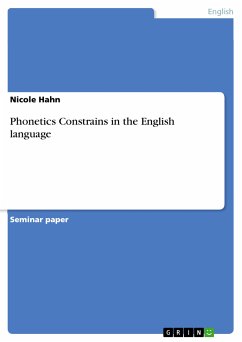Seminar paper from the year 2004 in the subject English Language and Literature Studies - Linguistics, grade: 2,3, University of Wuppertal, course: Contrastive Phonology, language: English, abstract: The constraints on sequences of segments are called phonotactic con -straints or phonotactics of a language. Word phonotactics in English are based on syllable phonotactics. This means that only clusters which can begin a syllable can begin a word and that a possible cluster at the end of a syllable can end a word. In multisyllabic words, the clusters consist of syllable final and syllable initial sequences. A word like instruct can be divided into well-formed syllables /In $ strΛkt/, because the word final and initial syllables consist of possible constraints in English. The arrangement of different phonemes is restricted. Some sequences are possible but have no meaning; some are not possible words in the English language. Nonsense words are possible words, respectively possible sequences of sounds of a particular language. They can be seen as accidental gaps in the vocabulary. The word Crike [krajk] obeys the phonological rules of the English language, but does not have any meaning. This phenomenon must be distinguished from non-words. Their sequences have no meaning either, but their sequences are not possible words of a language (For example bkli). If a form is not allowed by the phonotactics of a language there is said to be a systematic gap in the vocabulary. (Fromkin, Victoria. Rodman, Robert. An Introduction to Language. 6th edition. Hardcourt Brace College Publishers. United States of America. 1998)

